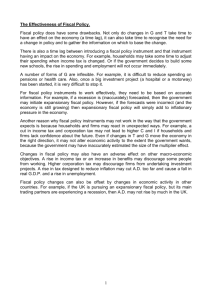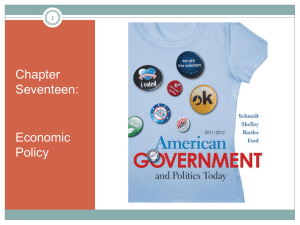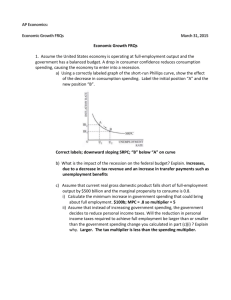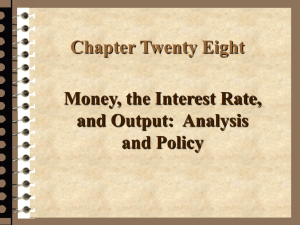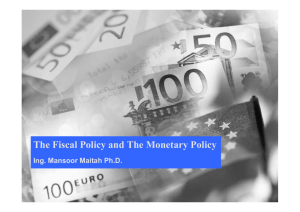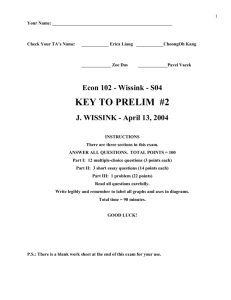Fiscal policy
advertisement
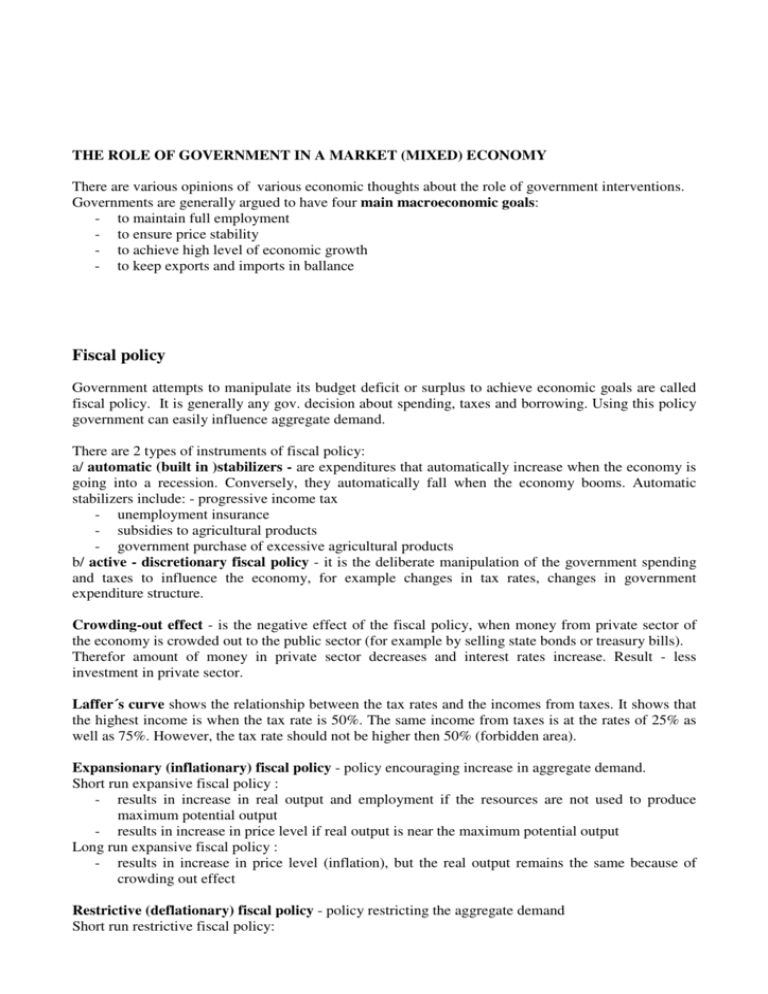
THE ROLE OF GOVERNMENT IN A MARKET (MIXED) ECONOMY There are various opinions of various economic thoughts about the role of government interventions. Governments are generally argued to have four main macroeconomic goals: - to maintain full employment - to ensure price stability - to achieve high level of economic growth - to keep exports and imports in ballance Fiscal policy Government attempts to manipulate its budget deficit or surplus to achieve economic goals are called fiscal policy. It is generally any gov. decision about spending, taxes and borrowing. Using this policy government can easily influence aggregate demand. There are 2 types of instruments of fiscal policy: a/ automatic (built in )stabilizers - are expenditures that automatically increase when the economy is going into a recession. Conversely, they automatically fall when the economy booms. Automatic stabilizers include: - progressive income tax - unemployment insurance - subsidies to agricultural products - government purchase of excessive agricultural products b/ active - discretionary fiscal policy - it is the deliberate manipulation of the government spending and taxes to influence the economy, for example changes in tax rates, changes in government expenditure structure. Crowding-out effect - is the negative effect of the fiscal policy, when money from private sector of the economy is crowded out to the public sector (for example by selling state bonds or treasury bills). Therefor amount of money in private sector decreases and interest rates increase. Result - less investment in private sector. Laffer´s curve shows the relationship between the tax rates and the incomes from taxes. It shows that the highest income is when the tax rate is 50%. The same income from taxes is at the rates of 25% as well as 75%. However, the tax rate should not be higher then 50% (forbidden area). Expansionary (inflationary) fiscal policy - policy encouraging increase in aggregate demand. Short run expansive fiscal policy : - results in increase in real output and employment if the resources are not used to produce maximum potential output - results in increase in price level if real output is near the maximum potential output Long run expansive fiscal policy : - results in increase in price level (inflation), but the real output remains the same because of crowding out effect Restrictive (deflationary) fiscal policy - policy restricting the aggregate demand Short run restrictive fiscal policy: - decreases real output and employment if the resources in the economy are not used to produce maximum potential output - decreases the prices if real output is near the maximum potential output Long run restrictive fiscal policy: - decrease in price level - decrease in nominal and real interest rate - unchanged level of real output and unemployment if private investment replaces government expenditures Monetary policy Monetary policy is the attempt by government or a central bank to manipulate the money supply, the supply of credit, interest rates, or any other monetary variables, to achieve the fulfilment of policy goals such as price stability. There are various definitions of the money supply ranging from M0 to M4. The central bank has the total control over M0. However, less than 1% of M4 is made up of notes and coins. So when the government wishes to control anything other than M0, it has to control the amount of money in the banking system and in the wider financial system, too. There are two types of tools (instruments) of monetary policy: a/ direct - regulation of loans by the government institutions, regulation of the credits on consumer goods b/ indirect - there are 3 main tools: - reserve ratio - determined by the central bank. It is the percentage of total deposits of a bank that has to be kept in the form of cash. If the central bank alters the value of the reserve ratio, it will actually influence the size of money supply. The higher the reserve ratio, the lower the size of money supply. - discount rate - it is the rate at which the central bank lend money to the commercial banks in need. It directly influences interest rates of commercial banks. If it increases, the interest rates increase, too. - open market operations - selling the bonds or treasury bills decreases the amount of money in the circular flow, buying them increases the size of money supply in the economy. Expansionary (inflationary) monetary policy - increases the amount of money in the circular flow of income. Restrictive (deflationary) monetary policy - decreases the amount of money in the circular flow of income. If the demand for money increases, the central bank can control either interest rate or money supply. There are 2 differnt opinions whether to control money supply or interest rate: 1. The Keynesian economists think that regulation of interest rates is important. They argue that it is important to regulate aggregate demand, which consists of investments, household spending, government expenditures and net exports. Investments are most dependent on the interest rates. 2. The monetarists argue that it is is important to control money supply. The base of their thinking is the quantitative theory of money, which says that money supply can influence price level (inflation) as well as real output (economic growth). Income policy Income policy is the policy designed to limit the growth of incomes directly. It can help to redice inflation caused by supply-side factors. By imposing maximum pay increases, the government breaks inflationary expectations and hence the cost push spiral and helps the economy return to price level stability. Social policy It is a policy whose main aim is to achieve certain social goals. There is no specific social policy. It is usually some kind of monetary or fiscal policy. Taxation is an example. Suppose the distribution of income is inequitable. To redistribute the income, the government can impose the taxes which reduce the income and wealth of richer groups in the society and use the money collected to increase the income and wealth of poorer groups. When the government wants to improve the level of education, it can increase its spending on it and ehen it wants to improve the living standard of low paid workers, it can impose minimum wage. These are considered to be social policies but in origin they are fiscal. Foreign trade policy It is a policy that can influence the workings of international trade. All countries choose to adopt protectionist policies to some extent because they want to protect their economies from destruction by huge imports or dumping. These protectionist policies are called trade barriers. The most important ones are tariffs and quotas, but there are some others as well. A tariff is a tax on imported goods and sometimes called an import duty or a customs duty. It is used to restrict imports so that it raises the final price of imported goods, thus lowering the demand of them. A quota is a physical limit on the quantity of the good imported. It is an example of a physical control.





